Strategies for Waste Recycling: The Mechanical Performance of Concrete Based on Limestone and Plastic Waste
Abstract
:1. Introduction
2. Quarry Limestone Sand as Fine Aggregate for Concrete
2.1. Overview
2.2. Experimental Investigation
3. Plastics Waste as Additional Aggregate for Concrete
3.1. Plastic Waste Typologies used as Additional Aggregate for Concrete
3.2. Experimental Investigation
4. Performance Comparisons and Discussion
- Road pavements vibrated by power-operated machines.
- Road pavements vibrated by hand-operated machines.
- Mass foundations or lightly reinforced sections with vibrations.
- Repair and overlay of damaged, cement-based concrete surfaces in pavements, bridges, floors, and dams.
5. Conclusions
- In the case of quarry waste limestone sand used as partial replacement of the sand, and having the characteristic of a filler, if used in low quantities can lead to improvements in the mechanical characteristics of concrete. On the other hand, lower mechanical properties were reported when the quarry waste limestone sand is used in larger quantities. In the latter case, the loss in performance is such that it can be compensated for, with an increase in the cement content in the mix.
- In the case of concrete with plastic, for all the types of plastics analyzed, a reduction of the strength of concrete was reported, with higher reduction in strength with increasing percentage plastic content in the mix. This reduction is significant for low percentages of plastics and can halve the strength of the concrete for high amounts of plastics (around 30% of the original mixed volume of ordinary concrete). However, important information is obtained regarding the performance of plastic-based concrete; this information enables the exploitation of this waste in specific fields of application, satisfying particular performance requirements.
Author Contributions
Funding
Institutional Review Board Statement
Informed Consent Statement
Data Availability Statement
Conflicts of Interest
References
- Geyer, R.; Jambeck, J.R.; Law, K.L. Production, use, and fate of all plastics ever made. Sci. Adv. 2017, 3, e1700782. [Google Scholar] [CrossRef] [PubMed] [Green Version]
- Kaza, S.; Yao, L.C.; Bhada-Tata, P.; Van Woerden, F. What a Waste 2.0: A Global Snapshot of Solid Waste Management to 2050; Urban Development; World Bank: Washington, DC, USA, 2018; © World Bank. License: CC BY 3.0 IGO; Available online: https://openknowledge.worldbank.org/handle/10986/30317 (accessed on 12 October 2021).
- Kazemi, M.; Kabir, S.F.; Fini, E.H. State of the art in recycling waste thermoplastics and thermosets and their applications in construction. Resour. Conserv. Recycl. 2021, 174, 105776. [Google Scholar] [CrossRef]
- Venkatesh, N. Plastic Mix Concrete by Using Waste Plastic Powder and Plastic Granules with Workability Test. Int. J. Multidiscip. Res. Mod. Edu. 2017, 3, 23–27. [Google Scholar]
- Akinyele, J.O.; Ajede, A. The use of granulated plastic waste in structural concrete. Afr. J. Sci. Tech. Innov. Dev. 2018, 10, 169–175. [Google Scholar] [CrossRef]
- Qureshi, M.S.; Oasmaa, A.; Pihkola, H.; Deviatkin, I.; Tenhunen, A.; Mannila, J.; Minkkinen, H.; Pohjakallio, M.; Laine-Ylijoki, J. Pyrolysis of plastic waste: Opportunities and challenges. J. Anal. Appl. Pyrolysis 2020, 152, 104804. [Google Scholar] [CrossRef]
- Thiounn, T.; Smith, R.C. Advances and approaches for chemical recycling of plastic waste. J. Polym. Sci. 2020, 58, 1347–1364. [Google Scholar] [CrossRef] [Green Version]
- Di, J.; Reck, B.K.; Miatto, A.; Graedel, T.E. United States plastics: Large flows, short lifetimes, and negligible recycling. Res. Conservat. Recycl. 2021, 167, 105440. [Google Scholar] [CrossRef]
- Federbeton Confindustria. Rapporto di Filiera 2019. 2020. Available online: https://www.federbeton.it/ (accessed on 5 October 2021).
- Cavaleri, L.; Borg, R.P.; La Mantia, F.P.; Liguori, V. Quarry limestone dust as fine aggregate for concrete. In Proceedings of the IOP Conference Series: Materials Science and Engineering, FIB Conference: Sustainable Concrete: Materials and Structures, Valletta, Malta, 10 April 2018; Institute of Physics Publishing (IOP): Bristol, UK, 2018; Volume 442, p. 012003. Available online: https://iopscience.iop.org/article/10.1088/1757-899X/442/1/012003 (accessed on 10 October 2021).
- Bahoria, B.V.; Parbat, D.K.; Nagarnaik, P.B.; Waghe, U.P. Effect of characterization properties on compressive strength of concrete containing quarry dust and waste plastic as fine aggregate. Int. J. Civ. Eng. Tech. (IJCIET) 2017, 8, 699–707. [Google Scholar]
- Rai, B.; Kumar, S.; Satish, K. Effect of Quarry Waste on Self-Compacting Concrete Containing Binary Cementitious Blends of Fly Ash and Cement. Adv. Mater. Sci. Eng. 2016, 2016, 1326960. [Google Scholar] [CrossRef] [Green Version]
- Prakash, K.S.; Rao, C.H. Study on compressive strength of quarry dust as fine aggregate in concrete. Adv. Civ. Eng. 2016, 2016, 1742769. [Google Scholar] [CrossRef] [Green Version]
- Aishwaryalakshmi, V.; Kumar, N.; Prathap, M.G.; Haribabu, S. Experimental study on strength of concrete by partial replacement of fine aggregates with quarry dust. Int. J. Civ. Eng Tech. (IJCIET) 2017, 8, 12–17. [Google Scholar]
- Jagadeesh, P.; Kumar, P.S.; Prakash, S.S.V. Influence of quarry dust on compressive strength of concrete. Indian J. Sci. Tech. 2016, 9, 93663. [Google Scholar] [CrossRef]
- Lim, S.K.; Tan, C.S.; Li, B.; Ling, T.; Hossain, M.U.; Poon, C.S. Utilizing high volumes quarry wastes in the production of lightweight foamed concrete. Constr. Build. Mater. 2017, 151, 441–448. [Google Scholar] [CrossRef]
- Kankam, C.K.; Meisuh, B.K.; Sossou, G.; Buabin, T.K. Stress-strain characteristics of concrete containing quarry rock dust as partial replacement of sand. Case Stud. Constr. Mater. 2017, 7, 66–72. [Google Scholar] [CrossRef]
- Thomas, J.; Harilal, B. Properties of cold bonded quarry dust coarse aggregates and its use in concrete. Cem. Concr. Compos. 2016, 62, 67–75. [Google Scholar] [CrossRef]
- André, A.; De Brito, J.; Rosa, A.; Pedro, D. Durability performance of concrete incorporating coarse aggregates from marble industry waste. J. Cleaner Product. 2014, 65, 389–396. [Google Scholar] [CrossRef]
- Mansor, A.M.; Elshab, A.A.; Borg, R.P.; Hamed, A.M. Effect of Marble Waste sand Waste on the properties of Self Compacting Concrete. In Proceedings of the SynerCrete’18: Interdisciplinary Approaches for Cement-Based Materials and Structural Concrete: Synergizing Expertise and Bridging Scales of Space and Time. (SynerCrete’18), Funchal, Portugal, 24–26 October 2018. Final Conference of COST Action TU1404. [Google Scholar] [CrossRef]
- Sabău, M.; Vargas, J. Use of e-plastic waste in concrete as a partial replacement of coarse mineral aggregate. Comput. Concr. 2018, 21, 377–384. [Google Scholar]
- Siddique, R.; Khatib, J.; Kaur, I. Use of recycled plastic in concrete: A review. Waste Manag. 2008, 28, 1835–1852. [Google Scholar] [CrossRef]
- Hameed, A.M.; Ahmed, B.A.F. Employment the plastic waste to produce the lightweight concrete. Energy Procedia 2019, 157, 30–38. [Google Scholar] [CrossRef]
- Borg, R.P.; Baldacchino, O.; Ferrara, L. Early age performance and mechanical characteristics of PET fibre reinforced concrete. Constr. Build. Mater. 2016, 108, 29–47. [Google Scholar] [CrossRef] [Green Version]
- Kepniak, M.; Woyciechowski, P.; Franus, W. Chemical and physical properties of limestone powder as a potential microfiller of polymer composites. Arch. Civ. Eng. 2017, 63, 67–78. [Google Scholar] [CrossRef] [Green Version]
- Kepniak, M.; Woyciechowski, P.; Lukowaki, P.; Kuziak, J.; Kobylka, R. The Durability of Concrete Modified by Waste Limestone Powder in the Chemically Aggressive Environment. Materials 2019, 12, 1693. [Google Scholar] [CrossRef] [PubMed] [Green Version]
- Ramesan, A.; Babu, S.S.; Lal, A. Durability and Bonding Characteristics of Plastic Aggregate Concrete. IOSR J. Mech. Civ. Eng. 2015, 12, 30–37. [Google Scholar]
- Visweswara, S.D.; Sunil kumar, K.; Vimala, A. Experimental Investigation on Mechanical and Durability Properties of Concrete with Plastic Waste. Int. J. Eng. Technol. 2018, 7, 32–36. [Google Scholar]
- Nwaubani, S.O.; Parsons, L.A. Properties, durability and microstructure of concrete incorporating waste electrical and electronic plastics as partial replacement for aggregates in concrete. Case Stud. Constr. Mater. 2021, 15, e00731. [Google Scholar] [CrossRef]
- Rahimi, A.; García, J.M. Chemical recycling of waste plastics for new materials production. Nat. Rev. Chem. 2017, 1, 0046. [Google Scholar] [CrossRef]
- Ferrándiz-Mas, V.; Sarabia, L.A.; Ortiz, M.C.; Cheeseman, C.R.; García-Alcocel, E. Design of bespoke lightweight cement mortars containing waste expanded polystyrene by experimental statistical methods. Mater. Des. 2016, 89, 901–912. [Google Scholar] [CrossRef] [Green Version]
- Hussien, R.M.; Abd El-Hafez, L.M.; Mohamed, R.A.S.; Faried, A.S.; Fahmy, N.G. Influence of nano waste materials on the mechanical properties, microstructure, and corrosion resistance of self-compacted concrete. Case Stud. Constr. Mater. 2022, 16, e00859. [Google Scholar] [CrossRef]
- Srividya, T.; Kannan Rajkumar, P.R.; Sivasakthi, M.; Sujitha, A.; Jeyalakshmi, R. A state-of-the-art on development of geopolymer concrete and its field applications. Case Stud. Constr. Mater. 2022, 16, e00812. [Google Scholar]
- Zeyad, A.M.; Magbool, H.M.; Tayeh, B.A.; Garcez de Azevedo, A.R.; Abutaleb, A.; Hussain, Q. Production of geopolymer concrete by utilizing volcanic pumice dust. Case Stud. Constr. Mater. 2022, 16, e00802. [Google Scholar] [CrossRef]
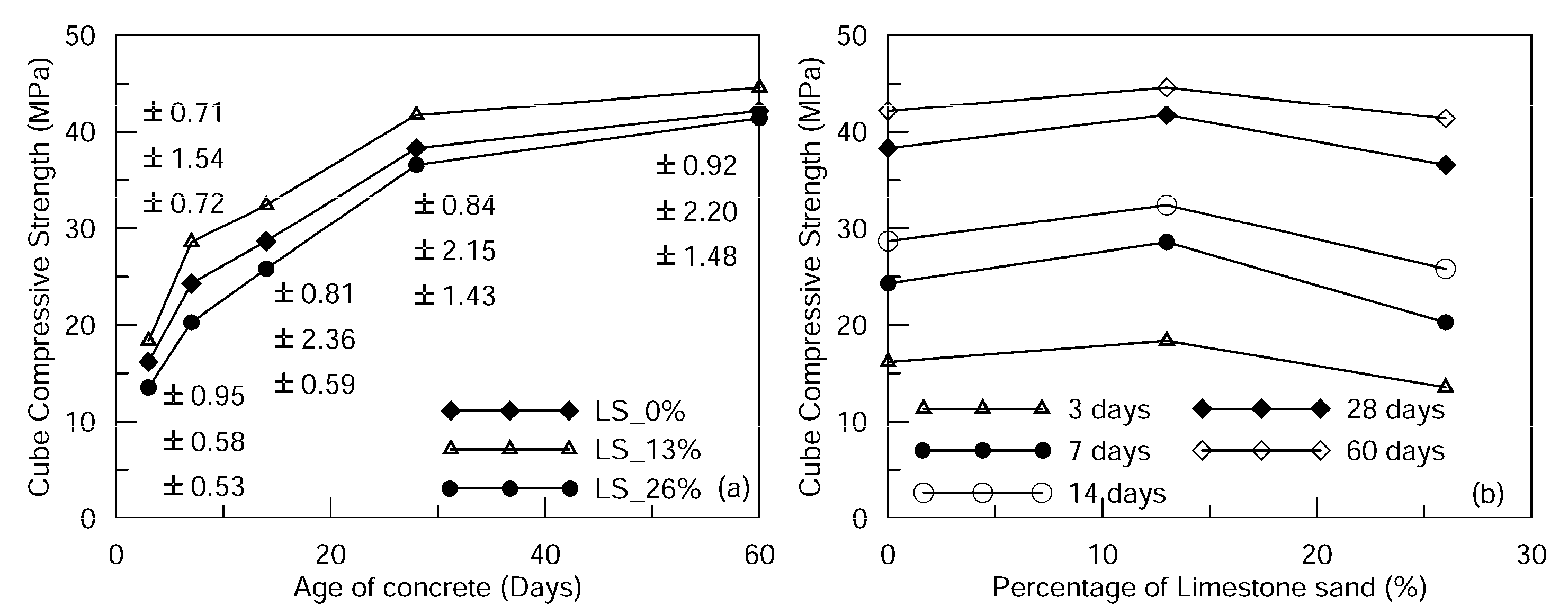

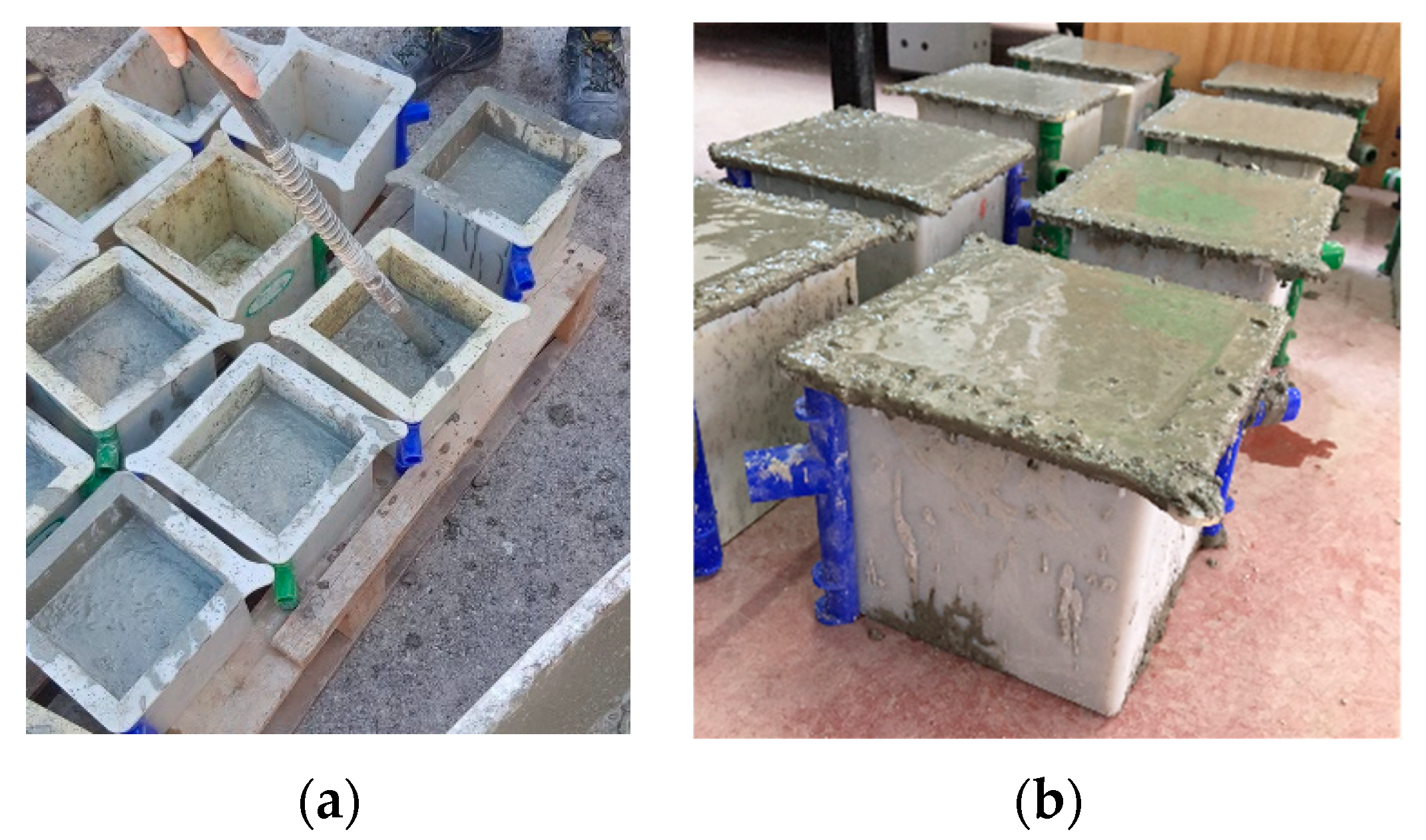


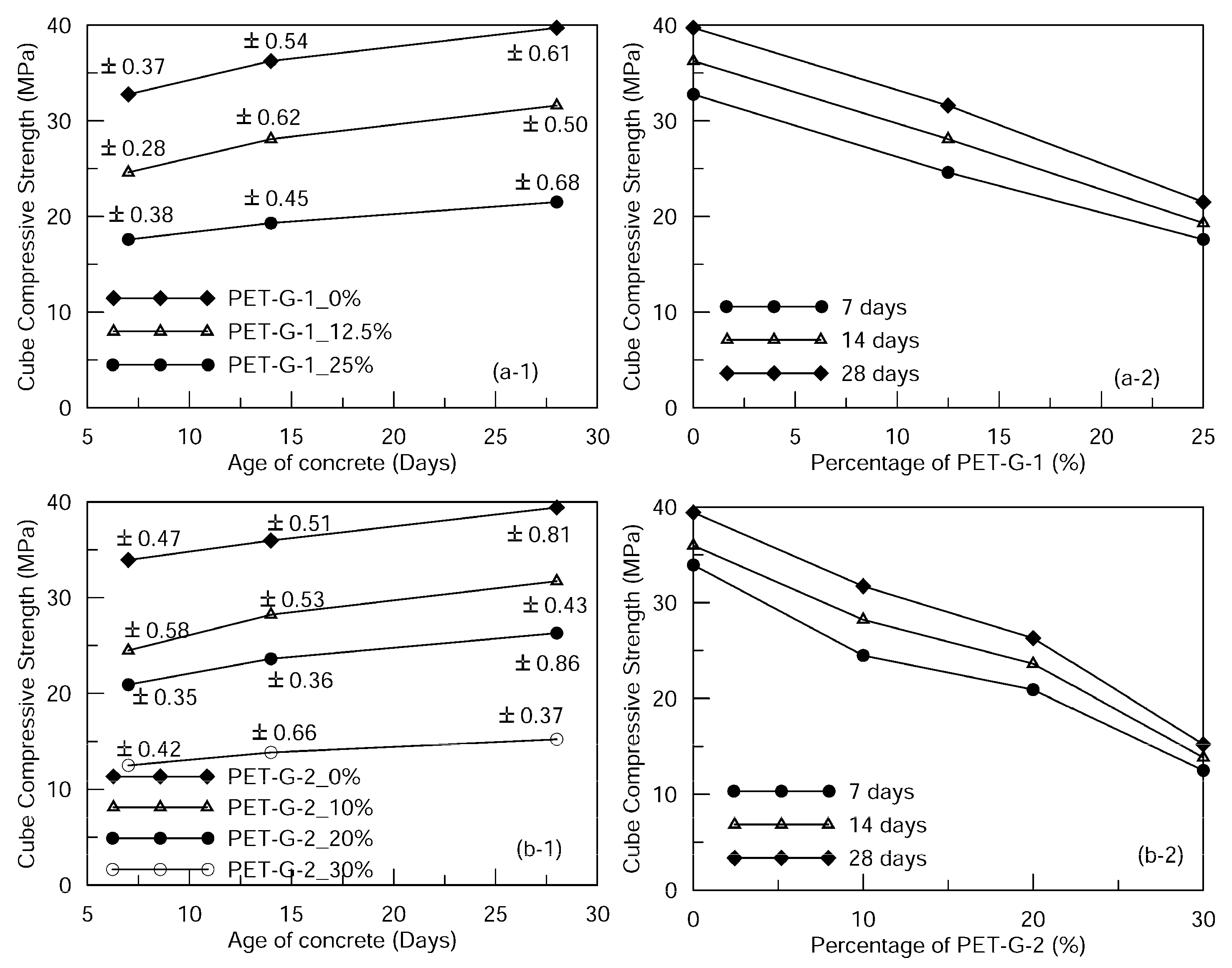
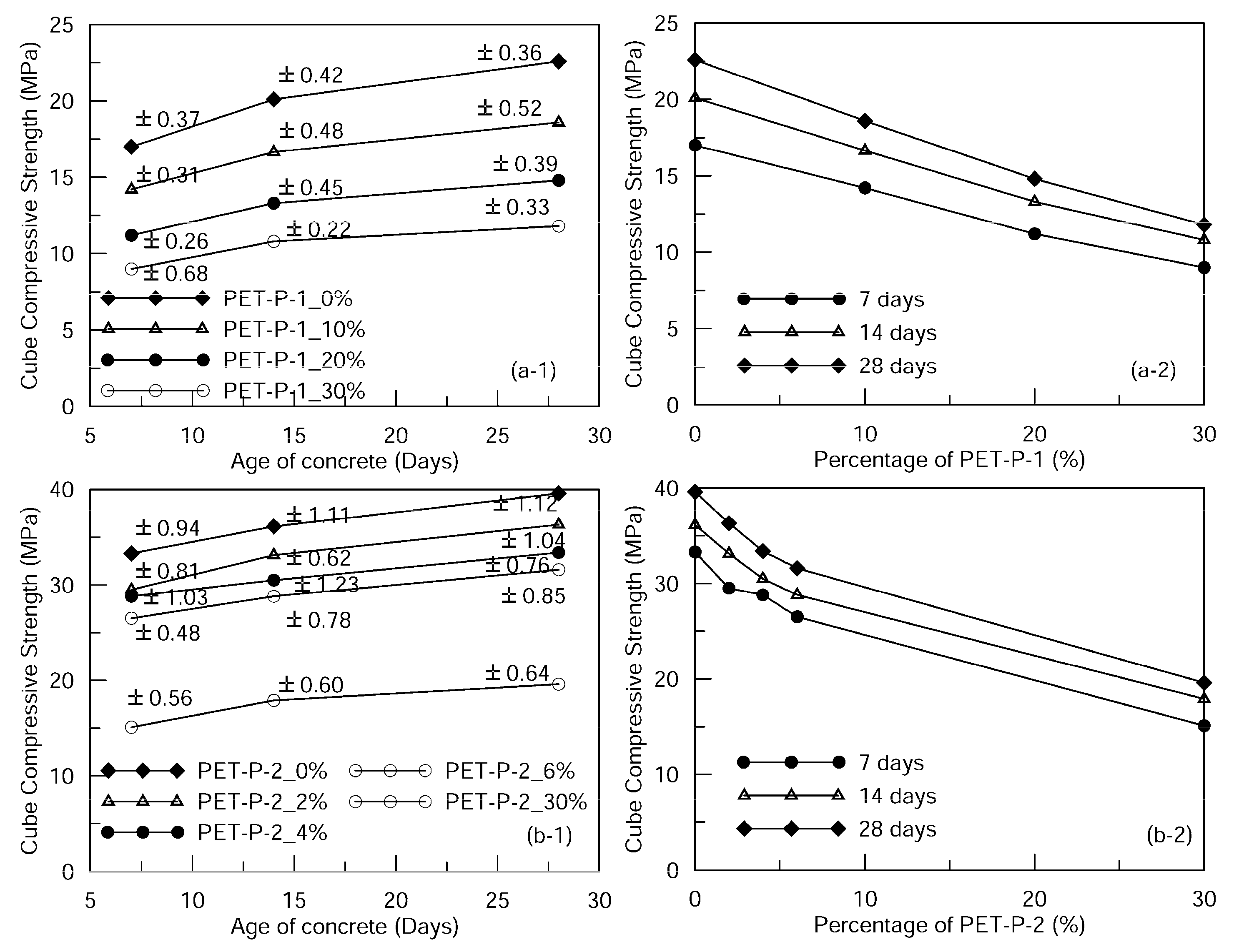
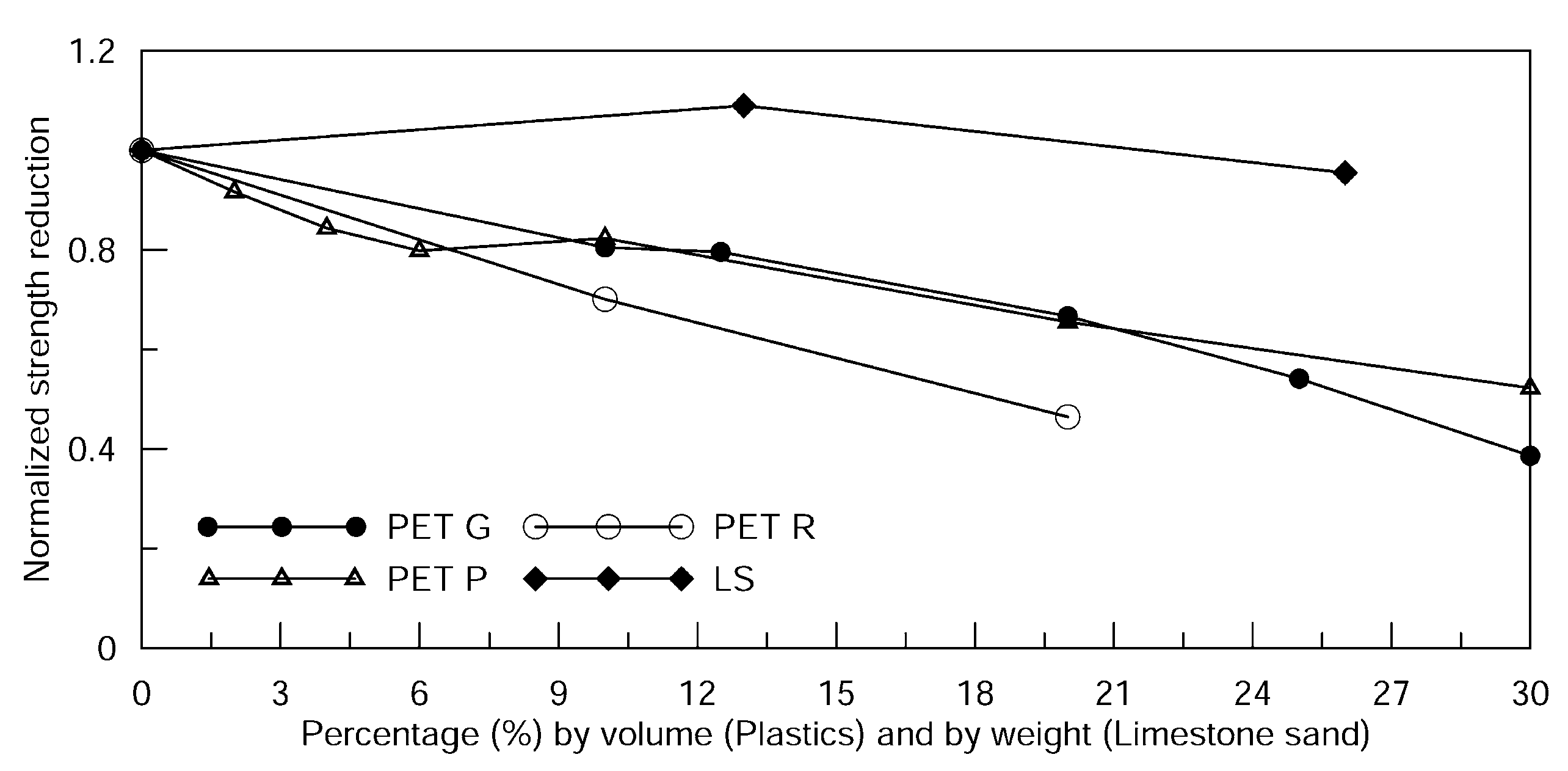
| 1/21 of a Cubic M | |||
|---|---|---|---|
| Control Mix Components [kg] | Mix with 13% (of Ordinary Sand) of Fine Quarry Waste [kg] | Mix with 26% (of Ordinary Sand) of Fine Quarry Waste [kg] | |
| Cement | 15 | 15 | 15 |
| Water | 7.5 | 7.5 | 7.5 |
| Fine Aggregate | 35 | 31 | 27 |
| Quarried Waste Sand | 0 | 4 | 8 |
| Coarse Aggregate | 38 | 38 | 38 |
| waste by weight percentage introduction * (%) | 11 | 23 | |
| 1 Cubic M | |||
| Cement | 315 | 315 | 315 |
| Water | 157 | 157 | 157 |
| Fine Aggregate | 735 | 651 | 567 |
| Quarried Waste Sand | 0 | 84 | 168 |
| Coarse Aggregate | 798 | 798 | 798 |
| 1/21 of a Cubic M + Waste | |||
|---|---|---|---|
| Control Mix Comp. [kg] | Mix with 10% Waste by Volume [kg] | Mix with 20% Waste by Volume [kg] | |
| Cement | 15.75 | 15.75 | 15.75 |
| Water | 9.45 | 9.45 | 9.45 |
| Fine Aggregate | 39.9 | 39.9 | 39.9 |
| Flake plastic | 0 | 2 | 4 |
| Coarse Aggregate | 36.75 | 36.75 | 36.75 |
| By volume Percentage of flake plastic (%) | 10 | 20 | |
| 1 Cubic M + Waste | |||
| Cement | 330.7 | 330.7 | 330.7 |
| Water | 198.5 | 198.5 | 198.5 |
| Fine Aggregate | 837.9 | 837.9 | 837.9 |
| Flake plastic | 0 | 42 | 84 |
| Coarse Aggregate | 771.7 | 771.7 | 771.7 |
| 5.67/1000 of a Cubic M + Waste | ||||||
|---|---|---|---|---|---|---|
| Control Mix Comp. [kg] | Mix with 10% by Volume [kg] | Mix with 20% by Volume [kg] | Mix with 30% by Volume [kg] | Mix with 12.5% by Volume [kg] | Mix with 25% by Volume [kg] | |
| Cement | 2.45 | 2.45 | 2.45 | 2.45 | 2.45 | 2.45 |
| Water | 1.22 | 1.22 | 1.22 | 1.22 | 1.22 | 1.22 |
| Fine Aggregate | 3.34 | 3.34 | 3.34 | 3.34 | 3.34 | 3.34 |
| Granulated plastic | 0 | 0.3 | 0.64 | 0.96 | 0.375 | 0.75 |
| Coarse Aggregate | 6.45 | 6.45 | 6.45 | 6.45 | 6.45 | 6.45 |
| By volume Percentage of granulated plastic (%) | 10 | 20 | 30 | 12.5 | 25 | |
| 1 Cubic M + Waste | ||||||
| Cement | 430 | 430 | 430 | 430 | 430 | 430 |
| Water | 215 | 215 | 215 | 215 | 215 | 215 |
| Fine Aggregate | 589 | 589 | 589 | 589 | 589 | 589 |
| Granulated plastic | 0 | 52.9 | 112.9 | 169 | 66.1 | 132.3 |
| Coarse Aggregate | 1137 | 1137 | 1137 | 1137 | 1137 | 1137 |
| 5.67/1000 of a Cubic M | ||||
|---|---|---|---|---|
| Control Mix Comp. [kg] | Mix with 10% by Volume [kg] | Mix with 20% by Volume [kg] | Mix with 30% by Volume [kg] | |
| Cement | 1.75 | 1.75 | 1.75 | 1.75 |
| Water | 0.87 | 0.87 | 0.87 | 0.87 |
| Fine Aggregate | 3.71 | 3.71 | 3.71 | 3.71 |
| Sand plastic | 0 | 0.371 | 0.742 | 1.113 |
| Coarse Aggregate | 6.45 | 6.45 | 6.45 | 6.45 |
| By volume Percentage of sand plastic (%) | 10 | 20 | 30 | |
| 1 Cubic M | ||||
| Cement | 308 | 308 | 308 | 308 |
| Water | 153 | 153 | 153 | 153 |
| Fine Aggregate | 654 | 654 | 654 | 654 |
| Sand plastic | 0 | 65 | 130 | 195 |
| Coarse Aggregate | 1137 | 1137 | 1137 | 1137 |
| 5.67/1000 of a Cubic M | |||||
|---|---|---|---|---|---|
| Control Mix Comp. [kg] | Mix with 2% by Volume [kg] | Mix with 4% by Volume [kg] | Mix with 6% by Volume [kg] | Mix with 30% by Volume [kg] | |
| Cement | 2.45 | 2.45 | 2.45 | 2.45 | 2.45 |
| Water | 1.22 | 1.22 | 1.22 | 1.22 | 1.22 |
| Fine Aggregate | 3.71 | 3.71 | 3.71 | 3.71 | 3.71 |
| Sand plastic | 0 | 0.075 | 0.150 | 0.222 | 1.113 |
| Coarse Aggregate | 6.45 | 6.45 | 6.45 | 6.45 | 6.45 |
| By volume Percentage of sand plastic (%) | 2 | 4 | 6 | 30 | |
| 1 Cubic M | |||||
| Cement | 308 | 308 | 308 | 308 | 308 |
| Water | 153 | 153 | 153 | 153 | 153 |
| Fine Aggregate | 654 | 654 | 654 | 654 | 654 |
| Sand plastic | 0 | 13.22 | 26.40 | 39.7 | 195 |
| Coarse Aggregate | 1137 | 1137 | 1137 | 1137 | 1137 |
| Cement (Weight) | Water (Weight) | Sand (Weight) | Aggregate (Weight) | Waste Aggregate (Weight) | Type of Waste Aggregate | By Volume Percentage of Additional Waste | Strength at 28 Days (MPa) |
|---|---|---|---|---|---|---|---|
| 1.00 | 0.5 | 2.33 | 2.53 | 0.00 | Limestone sand | * | 38.3 |
| 2.07 | 2.53 | 0.26 | * | 41.74 | |||
| 1.80 | 2.53 | 0.5 | * | 36.57 | |||
| 1.00 | 0.5 | 1.363 | 2.622 | 0.00 | Granulated (PET-G1) | 0 | 39.73 |
| 1.363 | 2.622 | 0.153 | 12.5 | 31.6 | |||
| 1.363 | 2.622 | 0.306 | 25 | 21.5 | |||
| 1.00 | 0.5 | 1.514 | 2.622 | 0.00 | Granulated (PET-G2) | 0 | 39.42 |
| 1.514 | 2.622 | 0.163 | 10 | 31.72 | |||
| 1.514 | 2.622 | 0.327 | 20 | 26.28 | |||
| 1.514 | 2.622 | 0.490 | 30 | 15.23 | |||
| 1.00 | 0.5 | 2.120 | 3.671 | 0.000 | Powder (PET-P1) | 0 | 22.6 |
| 2.120 | 3.671 | 0.212 | 10 | 18.6 | |||
| 2.120 | 3.671 | 0.424 | 20 | 14.8 | |||
| 2.120 | 3.671 | 0.636 | 30 | 11.8 | |||
| 1.00 | 0.5 | 1.51 | 2.62 | 0.00 | Powder (PET-P2) | 0 | 39.5 |
| 1.51 | 2.62 | 0.05 | 2 | 36.3 | |||
| 1.51 | 2.62 | 0.10 | 4 | 33.4 | |||
| 1.51 | 2.62 | 0.15 | 6 | 31.6 | |||
| 1.51 | 2.62 | 0.64 | 30 | 19.6 | |||
| 1.00 | 0.5 | 2.53 | 2.33 | 0.00 | Flake (PET-R) | 0 | 18.452 |
| 2.53 | 2.33 | 0.13 | 10 | 12.924 | |||
| 2.53 | 2.33 | 0.25 | 20 | 8.572 |
Publisher’s Note: MDPI stays neutral with regard to jurisdictional claims in published maps and institutional affiliations. |
© 2022 by the authors. Licensee MDPI, Basel, Switzerland. This article is an open access article distributed under the terms and conditions of the Creative Commons Attribution (CC BY) license (https://creativecommons.org/licenses/by/4.0/).
Share and Cite
Ferrotto, M.F.; Asteris, P.G.; Borg, R.P.; Cavaleri, L. Strategies for Waste Recycling: The Mechanical Performance of Concrete Based on Limestone and Plastic Waste. Sustainability 2022, 14, 1706. https://doi.org/10.3390/su14031706
Ferrotto MF, Asteris PG, Borg RP, Cavaleri L. Strategies for Waste Recycling: The Mechanical Performance of Concrete Based on Limestone and Plastic Waste. Sustainability. 2022; 14(3):1706. https://doi.org/10.3390/su14031706
Chicago/Turabian StyleFerrotto, Marco Filippo, Panagiotis G. Asteris, Ruben Paul Borg, and Liborio Cavaleri. 2022. "Strategies for Waste Recycling: The Mechanical Performance of Concrete Based on Limestone and Plastic Waste" Sustainability 14, no. 3: 1706. https://doi.org/10.3390/su14031706







